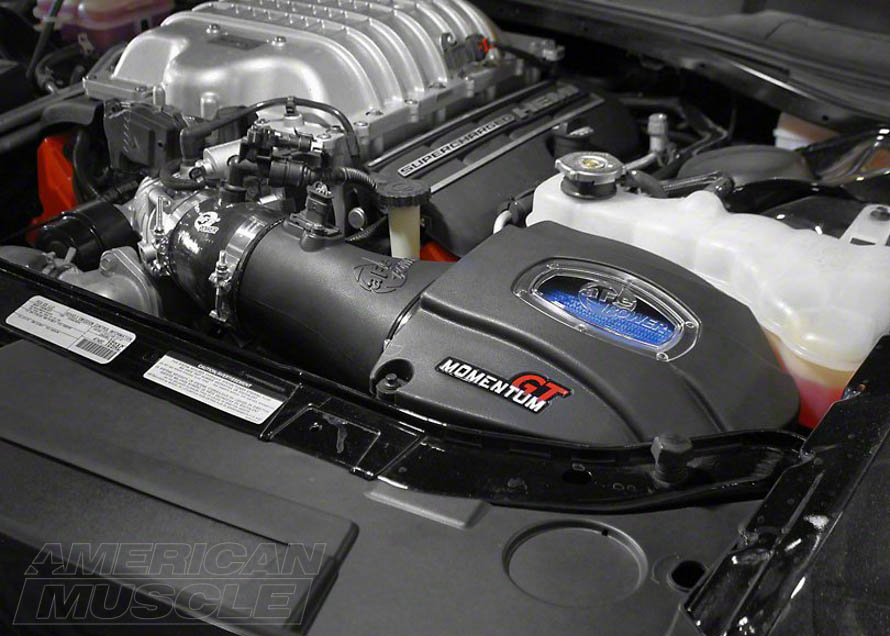Out of all the modern muscle cars, Challengers are the best throwback to the days of classic muscle cars. A side-by-side comparison of a first generation and third-gen Challenger would seem like a seamless transition from the 70s to the 2000s. However, when you pop the hoods, these new age engines look like alien technology next to the straightforward powerhouses of the 70s. The first thing you’re going to notice is the location of the air cleaners. One is atop the engine while the other runs toward the inner fender as a cold air intake system. Which sparks an interesting question: why install an aftermarket cold air intake?

The Benefits of Challenger Cold Air Intakes

Stock Intake Issues
When you look at the basic design of the stock intake system on a third-generation Challenger and an aftermarket set up, they run an identical route.
There are issues with these systems though; the biggest issue being how efficiently air can actually travel through them. The air filter itself is enclosed in a housing that only allows it to draw in air from one direction. It then travels a considerable distance through cheap plastic tubing and into the intake.
Aftermarket Cold Air Intakes and Why They Work
So what are aftermarket suppliers getting right with their cold air intakes vs the factory intake system? The filter is located in the same place as the stock filter is – tucked up near the radiator and away from the engine.
The air isn’t coming from outside the engine bay, but the air there is cooler. Can we extrapolate this a bit more? The last two sentences here sound disjointed even though I believe I understand what the intent is.
The filters aren’t limited to pulling the air from one direction then either; they can pull from multiple directions if not from all around it. The air is then sent through better constructed tubing that not only flows well, but the materials used in construction better limit heat transfer.
However, we still haven’t discussed why cold air is better for your Challenger. Well, why do forced induction units benefit from intercoolers? Cool air is more condensed than warm air. What this means is more oxygen can be squeezed into the same area. More air and fuel in the combustion chamber translates to a better running, more efficient engine. The use of a proper cold air intake will provide an increase in power and fuel economy.
Benefits of cold air Intakes:
- Condensed air entering the combustion chamber
- Increased horsepower
- Increased fuel economy
Aftermarket Cold Air Intake Offerings
There are a lot of different options of cold air intakes for third-gen Challengers and it can get quite overwhelming at points when trying to decide which works best. The number one question on most modders’ minds is who makes the best kit for your Challenger?
Airaid, K&N, and BBK have been known to produce the preferred cold air intakes for Challengers. If you want to keep shopping, keep their selection in mind as a standard.
For the most part, all cold air intakes are similar in design with some variances on materials and the filters. Some new intake options run just past the throttle body with two filters to draw in as much air as possible.
That concept is a bit different but similar in the sense they are meant to draw in as much air as possible. They aren’t exactly cold air intakes, but are great options for airflow nonetheless.
Cold Air Intake Installation
The good thing about cold air intakes is installation is incredibly easy to do. They may run a decent penny, but after you have it you won’t have to spend a dime for a shop to install it for you. All you need are basic hand tools and a few minutes of your time.
With Challengers, you will have to remove the air temperature sensor and relocate it to the aftermarket intake system, so be sure to disconnect the negative battery terminal before getting started. Once this is done, disconnect the sensor right away. This way you’re less likely to damage the sensor.
Next you want to go ahead and remove the intake tube, and then the air box. Before removing the airbox, be sure to remove the crankcase breather tube. Then you can go ahead and remove the air box and prepare to install the cold air intake system. Install the aftermarket intake system in the reverse steps.
Challenger Shaker Hoods
We’ve all fallen in love with the rebirth of Shaker hoods on Challengers. Not you? Yeah you did, don’t lie.
Challengers with factory shaker hoods really aren’t going to need any intake upgrades to help get a hold of cooler air. The shaker itself isn’t just some aesthetic showpiece. If you take a closer look at the design there are two ports on top that peak out of the hood. These are actually where the engine draws in air.
Air really won’t get much cooler than it will outside the engine bay. Additionally, these cars come factory equipped with an open, Mopar Performance, filter element under the hood; all the reason more to love this design. If you’re the owner of a shaker Challenger and read to this point only to hear you don’t need to worry about a cold air intake, thanks for sticking with us; you’re awesome.